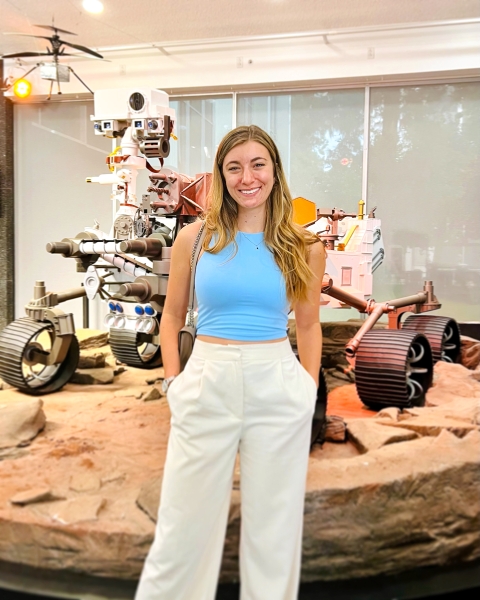Serena Tramm '20, Mechanical Engineering
March 24, 2025
For millennia, countless humans have turned their eyes skyward and wondered what lies beyond our planet. However, only a precious few actually play a part in finding answers.

As an applied science systems lead engineer at the NASA Jet Propulsion Laboratory, Serena Tramm '20 plays a role in gathering data from distant worlds to answer some of science's biggest questions. Photo by Jeannette Tramm P’20
"My job is kind of like that bridge between the question and figuring out how to take the data that can answer it,” says Serena Tramm '20, an applied science systems lead engineer at the NASA Jet Propulsion Laboratory (JPL) in La Cañada Flintridge, Calif.
Tramm wasn't someone who had always dreamed of exploring space. Instead, an internship as a systems operations engineer with Northrop Grumman and an unforgettable astrophysics class taught by Professor Michele Thornley, physics & astronomy, got the mechanical engineering major thinking about how she could apply her skills to the great beyond.
"I was really able to dip my toe into the subject at Bucknell, which helped me figure out that it was something I wanted to explore more," says Tramm.
With the help of her professors, she was accepted into a graduate astrophysics program at Rochester Institute of Technology. There, she discovered a love of instrument engineering for astrophysics, which involved launching sounding rockets, a type of rocket that carries scientific instruments, into space. Tramm's graduate school research helped her formulate a clear picture of her ideal career.
"I didn't think it was possible to work for NASA because working at NASA is kind of everyone's pipe dream," she says. "But when I got the job offer, I knew that it was exactly what I wanted to do. At JPL, I get to work in between the worlds of science and engineering."
Tramm has worked on instrument operations for the Mars Perseverance rover and earth-observing satellites like the Sentinel-6, which is key in measuring sea-surface heights and understanding climate change.
"When I talk about instrumentation, it's basically anything on board that's collecting data," says Tramm, whether that means taking spectroscopy measurements of rocks in the search for evidence of life on Mars or assessing the height of water anywhere on Earth. "Everyone I work with is doing something that's never been done before. We're always doing things for the first time."

